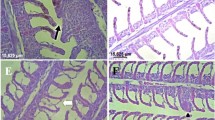Abstract.
When given orally, quinine or salinomycin cause irreversible damage to the plasmodial developmental stages of Henneguya sp., a gill parasite in the tapir fish Gnathonemus petersii. Naturally infected tapir fish measured 75–169 mm in total length and their total weight ranged over 4.3–11.7 g. The fish bore 7–77 plasmodia in their gill arches. Medicinal food containing either quinine (5 g/1000 g food) or salinomycin (0.075 g/1000 g food) was given once a day to naturally infected fish in a food chain via water fleas (Daphnia spp) for a period of 3, 6, or 9 days. From the monitored feeding of the tapir fish and weight determinations of the water fleas, it was calculated that gross uptake was 18.5 µg/kg body weight fish daily for pure salinomycin and was 1.25 mg/kg body weight daily for quinine. After the end of the experiments, the fish were sacrificed and the plasmodia were carefully prepared from the gill arches and processed for transmission electron microscopy. As seen by ultrastructure investigations, for both substances the grade of damage in the parasites correlated positively with the period of application. When quinine was given for a 3-day period, the trophozoite ecto- and endoplasm exerted numerous vacuoles, caused by the drug, and the presporogonous and the pansporoblastic stages were malformed. Following a 6-day period, numerous abortive polar capsules were found in the trophozoite cytoplasm. To a large extent, the limiting membranes of the polaroblasts and valvogenic cells were destroyed. In addition, deep clefts between the polaroblasts, the valvogenic cells and between the two sporoblasts were observed. Following a 9-day treatment, all damage increased and, in addition, generative cells and two-cell stages were no longer detectable. As a first sign for the effects of salinomycin, following a 3-day treatment, a shrinking of the whole plasmodia occurred and the sutures in the pansporoblasts were enlarged. The polar capsules were malformed and the zonar structures of the polar filament were no longer detectable. The sporoplasmosomes were more electron-pale than those of the control samples. After a 9-day treatment, the pansporoblasts were completely destroyed. Under the experimental conditions chosen, both compounds were very well tolerated by the fishes.
Similar content being viewed by others
Author information
Authors and Affiliations
Additional information
Electronic Publication
Rights and permissions
About this article
Cite this article
Dohle, A., Schmahl, G., Raether, W. et al. Effects of orally administered chemotherapeutics (quinine, salinomycin) against Henneguya sp. Thelohán, 1892 (Myxozoa: Myxobolidae), a gill parasite in the tapir fish Gnathonemus petersii Günther, 1862 (Teleostei). Parasitol Res 88, 861–867 (2002). https://doi.org/10.1007/s00436-002-0614-7
Received:
Accepted:
Issue Date:
DOI: https://doi.org/10.1007/s00436-002-0614-7




